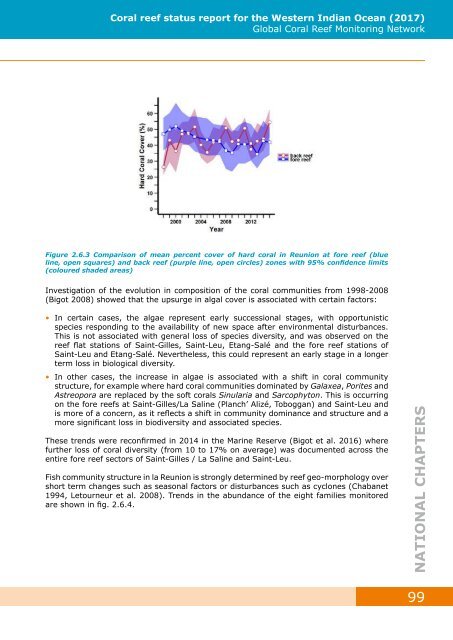GCRMN_COI_2017-Western Indian Ocean Reef Status
GCRMN Western Indian Ocean Coral Reef Status report for 2017. Produced by the Indian Ocean Commission and CORDIO East Africa
GCRMN Western Indian Ocean Coral Reef Status report for 2017. Produced by the Indian Ocean Commission and CORDIO East Africa
Create successful ePaper yourself
Turn your PDF publications into a flip-book with our unique Google optimized e-Paper software.
Coral reef status report for the <strong>Western</strong> <strong>Indian</strong> <strong>Ocean</strong> (<strong>2017</strong>)<br />
Global Coral <strong>Reef</strong> Monitoring Network<br />
Figure 2.6.3 Comparison of mean percent cover of hard coral in Reunion at fore reef (blue<br />
line, open squares) and back reef (purple line, open circles) zones with 95% confidence limits<br />
(coloured shaded areas)<br />
Investigation of the evolution in composition of the coral communities from 1998-2008<br />
(Bigot 2008) showed that the upsurge in algal cover is associated with certain factors:<br />
• In certain cases, the algae represent early successional stages, with opportunistic<br />
species responding to the availability of new space after environmental disturbances.<br />
This is not associated with general loss of species diversity, and was observed on the<br />
reef flat stations of Saint-Gilles, Saint-Leu, Etang-Salé and the fore reef stations of<br />
Saint-Leu and Etang-Salé. Nevertheless, this could represent an early stage in a longer<br />
term loss in biological diversity.<br />
• In other cases, the increase in algae is associated with a shift in coral community<br />
structure, for example where hard coral communities dominated by Galaxea, Porites and<br />
Astreopora are replaced by the soft corals Sinularia and Sarcophyton. This is occurring<br />
on the fore reefs at Saint-Gilles/La Saline (Planch’ Alizé, Toboggan) and Saint-Leu and<br />
is more of a concern, as it reflects a shift in community dominance and structure and a<br />
more significant loss in biodiversity and associated species.<br />
These trends were reconfirmed in 2014 in the Marine Reserve (Bigot et al. 2016) where<br />
further loss of coral diversity (from 10 to 17% on average) was documented across the<br />
entire fore reef sectors of Saint-Gilles / La Saline and Saint-Leu.<br />
Fish community structure in la Reunion is strongly determined by reef geo-morphology over<br />
short term changes such as seasonal factors or disturbances such as cyclones (Chabanet<br />
1994, Letourneur et al. 2008). Trends in the abundance of the eight families monitored<br />
are shown in fig. 2.6.4.<br />
NATIONAL CHAPTERS<br />
99


















